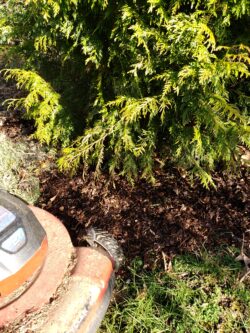
Arborist Advice: Mulch your trees
Our arborists recommend mulching your trees because it is one of the simplest and most beneficial ways of caring for your trees. Mulching is simply adding a layer of protective material at the base of your trees.
Benefits of Mulching
Mulching protects your trees by reducing water loss through evaporation, preventing soil erosion, controlling weeds that compete for nutrients and water, and moderating soil temperatures.

Mulching also reduces the need for mowing or trimming near the tree base thereby reducing the likelihood of tree damage from lawn care equipment.
Proper Technique
We recommend using an organic material that breaks down slowly rather than synthetic materials such as stained and shredded tires that are sold at some gardening stores. Unlike synthetic materials, as organic mulch breaks down, it enriches the soil. Arborist wood chips, bark dust, and leaves are all good choices of organic mulch materials.

When woody debris is fed through a wood chipper, the resulting mix of chipped wood, bark, and leaves are arborist wood chips. Arborist wood chips, seen above, can usually be found available for free, but are not as homogeneous as bark dust. Bark dust is available from local landscape supply yards at a price, but the color and size of the material is more homogeneous. Leaves are probably already available in your yard and are free, but decompose faster than wood chips or bark dust, requiring more frequent maintenance to keep the mulch at the desired depth. The material you choose may depend on what’s already in your yard, your budget, and the desired look and uniformity of material for your landscape or walking paths.
When we perform tree care, we offer our clients the option to have the arborist wood chips left on their property for use as mulch. If you would like to have arborist wood chips delivered to your property at a different time, the Chip Drop website is the best way to get arborist wood chips more quickly. The website connects local arborists who have wood chips with local gardeners who want wood chips delivered to their property.

To mulch your trees, add your chosen material to a uniform depth of 2-4 inches in a flat donut shape around the tree. We have found a pitch fork to be a useful tool for this task. The inner circle of the donut should be near, but not touching the trunk. The base of the trunk should be fully exposed. The outer circle of the donut should extend to the drip line of the tree or to a minimum of three feet from the trunk. The photo below shows a tree properly mulched with arborist wood chips in a flat donut shape.

As the organic material breaks down throughout the year, add more mulch to maintain the ideal depth. Different materials break down at different rates depending on your backyard environment.
Risk of Improper Mulching

It is very important that the mulch is not piled against the tree trunk. Softened tree tissues from having mulch piled against the tree can invite fungal disease and insect infestation. Stem girdling roots, which are harmful to the tree, can also develop from piling mulch against the tree trunk.
It is also important that the mulch not be piled too deeply at any point along the flat donut shape. Deep mulch can reduce the penetration of water and air, which are necessary for proper tree root growth.
The depth of the material depends on the soil moisture and the mulch material choice. The lower end of the mulch depth range (2”) should be applied on wet soils or if the mulch is a finer material. The higher end of the mulch depth range (4”) should be applied on well-drained soils or if a courser material is used.
Properly mulching your trees is one of the simplest and most beneficial ways to help your trees grow healthy to full maturity.


